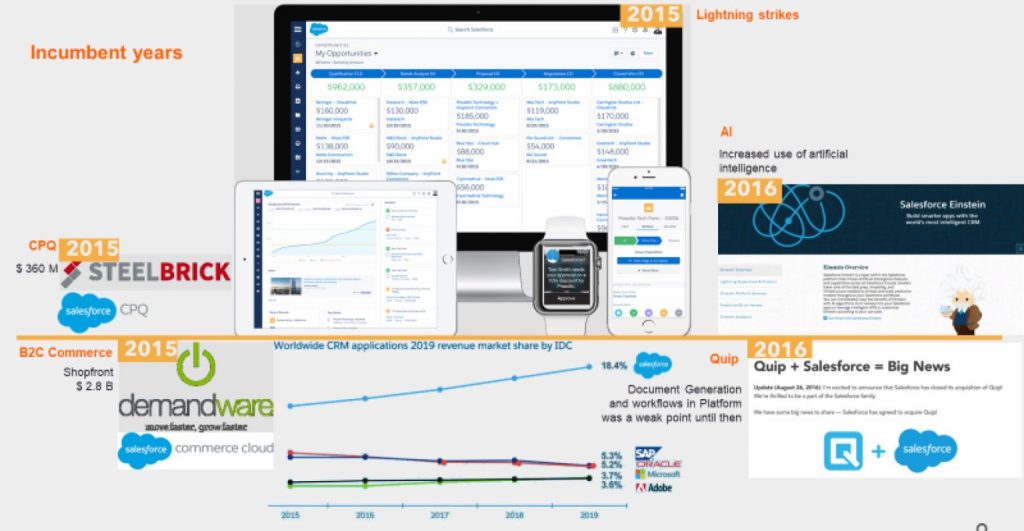In the previous blog, we learned about the advent of Configure Price Quote (CPQ) precursor on Salesforce. In this blog, we will discuss the pioneers who defined the category, coined the term CPQ and were the thought leaders of the middle office platform as we know it today.
Breaking Bad
As Salesforce expanded its market share, it started targeting smaller but growing enterprises that struggled to pay upfront costs, hindering their own expansion efforts.
Salesforce quickly went on to use its own force.com platform and build sales cloud, service cloud ─ all of which were going to dominate the system of engagement software (conned by business writer Geoffrey Moore) over the next decade ─ leveraging its unparalleled platform. It also licensed them as separate bundles with their add-ons, priced per user. Incumbents like SAP, Oracle, Infor, IBM remained entrenched in back office or system of records which process core business transactions, and happy to deal with functions such as Billing, Accounts, Spending, Enterprise Resource Planning (ERP).
Swell
In middle lay the middle office where another entrepreneur was eyeing a gap and exploring an opportunity leveraging Salesforce platform. Kirk Krappe, CEO (co-founder) of Apttus and the organization is widely credited with defining the category for CPQ software as a full-blown suite such as ‘Middle Office’. This is where the quotations are generated, products and options are configured after looking them up in complex catalogs, and more important Contracts are generated, clauses are selected. Additionally, there are documents, consent management and approval workflows. Middle office is an office suite, just like CRM is front office and ERP is back office. Kirk Krappe believed that there is a big enough uncatered market for a suite that can be built ground-up to address these unique capabilities. The suite must be sophisticated like CRM and ERP and needs configurability, extendibility, scalability like the best package software in the market. And thus, Apttus was founded in 2006 and it quickly rose to the very top of the game. Even Salesforce was known to have used Apttus from its early days for its own quoting, subscriptions, product lines, and add-ons. Apttus also used Salesforce Software as a Service (SaaS) subscription products as its training example for the courses delivered through Apttus University.
Ebb
With Oracle’s acquisition of BigMachines, the other big software houses like Salesforce and SAP also were eying acquisitions. The market was rife with the news of the impending acquisition of Apttus by Salesforce. However, all were quite caught aback by Salesforce announcing the acquisition of SteelBrick, a challenger back then. SteelBrick was still an underdog during Apttus’s heydays. Apttus was also more complete in its vision of Catalog Management, and offered product and attribute modeling with some flexibility regarding attribute inheritance from different hierarchies. Additionally, it had deeper integration with the Microsoft Word and Excel applications through plugins for document automation and templating. As the legal and most departments were predominantly Microsoft shops in almost all enterprises back then, Apttus was much easier to adopt in large enterprises. SteelBrick still used XSLFO for typesetting the quote and order documents, which was much more procode. Apttus stakeholders had to come to terms with the turn of events and eventually opted for an exit strategy, handing over the majority stakes to Private Equity (PE) Thoma Bravo around 2018.
Middle Office

Surprisingly even as late as 2019, Apttus remained the favorite of analysts, and used to be at the top right quadrant well until 2019. This was probably due to their strong response as a company to wean itself from a predominantly Salesforce-centric tech stack and create a truly Platform as a Service (PaaS) for Middle office named as Omni and embark on re-platforming Apttus on other Infrastructure as service (IaaS) clouds ground up. For example, some machinery was built leveraging Azure for the turbo engine that could be leveraged by even the Salesforce native version of Apttus to speed up the evaluation of complex context and pricing rule. Omni Middle office PaaS was potentially targeted towards being a system of experience and records completely for middle office workers of any organization, while synchronizing with a wide-ranging system of records such as Customer Relationship Management (CRMs), such as Microsoft’s own Dynamics.
Read the other blogs in the series: Part 1 Advent of CPQ , Part 3 The Evolution of CPQ on Salesforce and Beyond , Part 4 The Evolution of CPQ on Salesforce and Beyond.
Author’s Profile
Dipankar Barman
Enterprise Architect, Salesforce Practice Global







